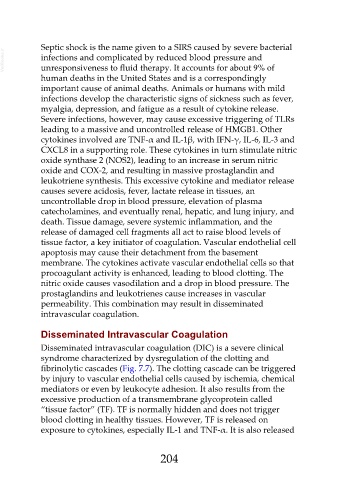Page 204 - Veterinary Immunology, 10th Edition
P. 204
Septic shock is the name given to a SIRS caused by severe bacterial
VetBooks.ir infections and complicated by reduced blood pressure and
unresponsiveness to fluid therapy. It accounts for about 9% of
human deaths in the United States and is a correspondingly
important cause of animal deaths. Animals or humans with mild
infections develop the characteristic signs of sickness such as fever,
myalgia, depression, and fatigue as a result of cytokine release.
Severe infections, however, may cause excessive triggering of TLRs
leading to a massive and uncontrolled release of HMGB1. Other
cytokines involved are TNF-α and IL-1β, with IFN-γ, IL-6, IL-3 and
CXCL8 in a supporting role. These cytokines in turn stimulate nitric
oxide synthase 2 (NOS2), leading to an increase in serum nitric
oxide and COX-2, and resulting in massive prostaglandin and
leukotriene synthesis. This excessive cytokine and mediator release
causes severe acidosis, fever, lactate release in tissues, an
uncontrollable drop in blood pressure, elevation of plasma
catecholamines, and eventually renal, hepatic, and lung injury, and
death. Tissue damage, severe systemic inflammation, and the
release of damaged cell fragments all act to raise blood levels of
tissue factor, a key initiator of coagulation. Vascular endothelial cell
apoptosis may cause their detachment from the basement
membrane. The cytokines activate vascular endothelial cells so that
procoagulant activity is enhanced, leading to blood clotting. The
nitric oxide causes vasodilation and a drop in blood pressure. The
prostaglandins and leukotrienes cause increases in vascular
permeability. This combination may result in disseminated
intravascular coagulation.
Disseminated Intravascular Coagulation
Disseminated intravascular coagulation (DIC) is a severe clinical
syndrome characterized by dysregulation of the clotting and
fibrinolytic cascades (Fig. 7.7). The clotting cascade can be triggered
by injury to vascular endothelial cells caused by ischemia, chemical
mediators or even by leukocyte adhesion. It also results from the
excessive production of a transmembrane glycoprotein called
“tissue factor” (TF). TF is normally hidden and does not trigger
blood clotting in healthy tissues. However, TF is released on
exposure to cytokines, especially IL-1 and TNF-α. It is also released
204

